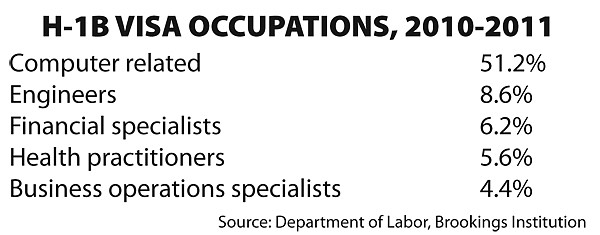 Facebook
Facebook
 X
X
 Instagram
Instagram
 TikTok
TikTok
 Youtube
Youtube

American engineers, scientists, and mathematicians can convincingly show that they are not in short supply, as corporations claim. But increasingly, politicians are siding with big business, which wants the government to loosen restrictions on the H-1B visa program, by which low- to mid-level technologists come to the United States each year from foreign countries.
The H-1B visa recipients, who must have a bachelor’s degree or equivalent experience, can stay for three years with an option to extend to six years. Now, the number permitted to enter is capped at 85,000 yearly. (This has changed through the years.) More than half of H-1B entrants are in computer-related fields, mostly from India.
San Diego’s Qualcomm is the fifth-largest user of H-1B talent among major U.S. multinational companies. The other four, beginning with the largest, are Microsoft, Intel, IBM, and Oracle, according to a study published last year by the Brookings Institution. In the 2010–2011 years, San Diego County was the nation’s 15th-largest user of H-1B employees.

Brookings interviewed numerous corporations for that study. The report stirred up a storm with such statements as “employers have a difficult time recruiting residents with the skills they need, largely blaming the weak foundation of secondary education in the United States…employers complain that there is a shortage of skilled workers…[some employers] mentioned that they must recruit at over 50 college campuses in the United States to find 100 [science, technology, engineering, and mathematics] employees.”
Gene Nelson of San Luis Obispo, a PhD in radiation biophysics and an opponent of H-1B, calls the Brookings study “pathetic baloney.” He and fellow anti-H-1B activists make a good case that the program is basically a scheme to lower the overall wage level in the engineering/computer profession, thus jacking up corporate profits and paving the way for absurdly high top-management pay.
But the opponents’ point of view is coming against powerful obstacles. In the 2012 election, both President Obama and Mitt Romney favored a loosening of H-1B restrictions. Mayor Michael Bloomberg of New York wants to eliminate the H-1B caps altogether.
Last month, 25 chambers of commerce from across the country announced a coalition named Business for Skilled Worker Immigration, which is pushing to increase availability of H-1B workers. The San Diego Regional Chamber of Commerce is one of the 25 founding members. Ruben Barrales, former head of the local chamber, is a member of Partnership for a New American Economy, which is promoting similar goals. Co-chairs include Mayor Bloomberg, Microsoft chief executive Steven Ballmer, and publisher Rupert Murdoch. The partnership claims that 76 percent of all voters favor reform of the skilled worker visa laws, including 87 percent of Democrats, 72 percent of Republicans, and 68 percent of Tea Party supporters.
“The status quo is not working,” laments the United States Chamber of Commerce. “The H-1B cap should be significantly raised…so that companies are able to respond adequately to real-world demands.”
At year end 2012, the House of Representatives passed the STEM (science, technology, engineering, and mathematics) Jobs Act of 2012, which would allocate 55,000 visas to high-skilled immigrants holding master’s or doctoral degrees from U.S. institutions. (This program, dealing with highly educated visa holders — not the kind generally admitted through H-1B — is not opposed by some anti–H-1B activists.)
Last August, a federal judge in Alabama threw out a lawsuit filed by an American employee of an India-based company providing H-1B services. The employee claimed that the Indian outsourcer broke the H-1B immigration rules; when the employee tried to complain, he was harassed. The judge said his grievances were not covered under Alabama law. However, a similar whistleblower case against the same company has been filed in California, and a criminal probe against the Indian company, based on the Alabama allegations, is still ongoing.
Despite all these setbacks, the H-1B foes continue battling what they believe are misconceptions. Nelson, for example, points out that under the law, H-1B workers are supposed to be paid a prevailing wage. But “the definition of ‘prevailing wage’ is so loophole-laden” that the H-1Bs’ pay is at least 20 percent lower than that of comparable Americans “and it may be closer to 50 percent,” he says.
That goes to the heart of the opponents’ arguments. “The underpayment of H-1Bs is well-established fact, not rumor, anecdote or ideology,” says the website of Professor Norman Matloff, who teaches computer science at the University of California at Davis. Such low wages bring down the overall salary level for American engineers and computer specialists, permitting companies to pile up profits, claiming there is a labor shortage. “There is no tech labor shortage,” says Matloff, and “no study, other than those sponsored by the industry, has ever shown a shortage.”
Says Matloff, “The world’s ‘best and brightest’ should be welcomed, but only a tiny percentage of H-1Bs are in that league.”
It appears that the companies that most enthusiastically utilize the H-1B program also take advantage of other profit-boosting opportunities that may hurt the nation as a whole. Ron Hira, professor at the Rochester Institute of Technology, says that the biggest users of H-1B are also among the companies that outsource the most jobs offshore.
Also, the largest H-1B users tend to be the same companies that, when locating a new plant, squeeze fat subsidies out of financially ailing American cities. These include Microsoft, Intel, IBM, Oracle, and Google, although San Diego’s Qualcomm does not appear to fit neatly into that category. In some cases, the H-1B user, getting a subsidy to build or relocate a plant, “says it will create X number of jobs but consciously avoids saying it will hire locals,” says Nelson. The H-1Bs then use services provided by American governments. It’s another case of “privatization of the gain and socialization of the costs.”
But in the current political environment, the H-1B opponents are having a tough time getting their messages across. ■
Contact Don Bauder at 619-546-8529


American engineers, scientists, and mathematicians can convincingly show that they are not in short supply, as corporations claim. But increasingly, politicians are siding with big business, which wants the government to loosen restrictions on the H-1B visa program, by which low- to mid-level technologists come to the United States each year from foreign countries.
The H-1B visa recipients, who must have a bachelor’s degree or equivalent experience, can stay for three years with an option to extend to six years. Now, the number permitted to enter is capped at 85,000 yearly. (This has changed through the years.) More than half of H-1B entrants are in computer-related fields, mostly from India.
San Diego’s Qualcomm is the fifth-largest user of H-1B talent among major U.S. multinational companies. The other four, beginning with the largest, are Microsoft, Intel, IBM, and Oracle, according to a study published last year by the Brookings Institution. In the 2010–2011 years, San Diego County was the nation’s 15th-largest user of H-1B employees.

Brookings interviewed numerous corporations for that study. The report stirred up a storm with such statements as “employers have a difficult time recruiting residents with the skills they need, largely blaming the weak foundation of secondary education in the United States…employers complain that there is a shortage of skilled workers…[some employers] mentioned that they must recruit at over 50 college campuses in the United States to find 100 [science, technology, engineering, and mathematics] employees.”
Gene Nelson of San Luis Obispo, a PhD in radiation biophysics and an opponent of H-1B, calls the Brookings study “pathetic baloney.” He and fellow anti-H-1B activists make a good case that the program is basically a scheme to lower the overall wage level in the engineering/computer profession, thus jacking up corporate profits and paving the way for absurdly high top-management pay.
But the opponents’ point of view is coming against powerful obstacles. In the 2012 election, both President Obama and Mitt Romney favored a loosening of H-1B restrictions. Mayor Michael Bloomberg of New York wants to eliminate the H-1B caps altogether.
Last month, 25 chambers of commerce from across the country announced a coalition named Business for Skilled Worker Immigration, which is pushing to increase availability of H-1B workers. The San Diego Regional Chamber of Commerce is one of the 25 founding members. Ruben Barrales, former head of the local chamber, is a member of Partnership for a New American Economy, which is promoting similar goals. Co-chairs include Mayor Bloomberg, Microsoft chief executive Steven Ballmer, and publisher Rupert Murdoch. The partnership claims that 76 percent of all voters favor reform of the skilled worker visa laws, including 87 percent of Democrats, 72 percent of Republicans, and 68 percent of Tea Party supporters.
“The status quo is not working,” laments the United States Chamber of Commerce. “The H-1B cap should be significantly raised…so that companies are able to respond adequately to real-world demands.”
At year end 2012, the House of Representatives passed the STEM (science, technology, engineering, and mathematics) Jobs Act of 2012, which would allocate 55,000 visas to high-skilled immigrants holding master’s or doctoral degrees from U.S. institutions. (This program, dealing with highly educated visa holders — not the kind generally admitted through H-1B — is not opposed by some anti–H-1B activists.)
Last August, a federal judge in Alabama threw out a lawsuit filed by an American employee of an India-based company providing H-1B services. The employee claimed that the Indian outsourcer broke the H-1B immigration rules; when the employee tried to complain, he was harassed. The judge said his grievances were not covered under Alabama law. However, a similar whistleblower case against the same company has been filed in California, and a criminal probe against the Indian company, based on the Alabama allegations, is still ongoing.
Despite all these setbacks, the H-1B foes continue battling what they believe are misconceptions. Nelson, for example, points out that under the law, H-1B workers are supposed to be paid a prevailing wage. But “the definition of ‘prevailing wage’ is so loophole-laden” that the H-1Bs’ pay is at least 20 percent lower than that of comparable Americans “and it may be closer to 50 percent,” he says.
That goes to the heart of the opponents’ arguments. “The underpayment of H-1Bs is well-established fact, not rumor, anecdote or ideology,” says the website of Professor Norman Matloff, who teaches computer science at the University of California at Davis. Such low wages bring down the overall salary level for American engineers and computer specialists, permitting companies to pile up profits, claiming there is a labor shortage. “There is no tech labor shortage,” says Matloff, and “no study, other than those sponsored by the industry, has ever shown a shortage.”
Says Matloff, “The world’s ‘best and brightest’ should be welcomed, but only a tiny percentage of H-1Bs are in that league.”
It appears that the companies that most enthusiastically utilize the H-1B program also take advantage of other profit-boosting opportunities that may hurt the nation as a whole. Ron Hira, professor at the Rochester Institute of Technology, says that the biggest users of H-1B are also among the companies that outsource the most jobs offshore.
Also, the largest H-1B users tend to be the same companies that, when locating a new plant, squeeze fat subsidies out of financially ailing American cities. These include Microsoft, Intel, IBM, Oracle, and Google, although San Diego’s Qualcomm does not appear to fit neatly into that category. In some cases, the H-1B user, getting a subsidy to build or relocate a plant, “says it will create X number of jobs but consciously avoids saying it will hire locals,” says Nelson. The H-1Bs then use services provided by American governments. It’s another case of “privatization of the gain and socialization of the costs.”
But in the current political environment, the H-1B opponents are having a tough time getting their messages across. ■
Contact Don Bauder at 619-546-8529
Comments